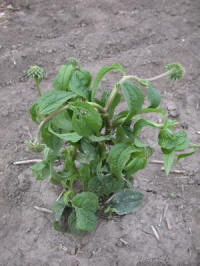|

Herbicide drift, soldier beetles and bagworms
By John
Fulton
 Send a link to a friend
Send a link to a friend
[June 09, 2009]
As if trees didn't have enough leaf problems
with diseases, herbicide drift has shown up in a big way this past
week. In all cases I have seen, the herbicides involved have been
members of the growth regulator group. This group includes products
such as 2,4-D and Banvel. Both products are used in agricultural
production, right of way maintenance and home lawn care.
|
 Leaf symptoms usually appear as some sort of abnormal growth.
This can include twisting, cupping, elongation and rolling.
Since the chemicals are systemic growth regulators, they move
throughout the trees (or shrubs or flowers) and then show the
most damage on the newest growing points. Think of what a
dandelion looks like after it has been treated with 2,4-D and
you get the general idea. Leaf symptoms usually appear as some sort of abnormal growth.
This can include twisting, cupping, elongation and rolling.
Since the chemicals are systemic growth regulators, they move
throughout the trees (or shrubs or flowers) and then show the
most damage on the newest growing points. Think of what a
dandelion looks like after it has been treated with 2,4-D and
you get the general idea.Where the products come from on your
trees is generally a big mystery. They can drift during the
actual spraying process (called spray drift), or they can come
back up off the ground as a vapor and move with winds (called
vapor drift). The difficulty with vapor drift is that it can
occur for up to a week and a half after the application and then
can drift for up to a mile and a half.

Some species of trees are more susceptible than others, and
the full-size leaves are less likely to show symptoms. Redbuds,
oaks and lilacs are among the most susceptible trees. Grapes and
tomatoes are among the most susceptible garden plants.
If you do have damage from herbicide drift, the end results
can vary. Generally, on established perennials, the damage is
ugly leaves for at least part of the growing season. You can
also have some "wave" to the ends of branches and possibly the
loss of some small branch ends. On younger stock, transplanted
in the last year or so, the damage may be fatal. It usually
takes several weeks to get an indication of the amount of damage
done, but a year is even better.
As for treatment, water when the weather stays dry. Don't
fertilize at this time. Remember that growth regulator
herbicides make things "grow themselves to death." You have to
walk a fine line between keeping the tree healthy and making
matters worse.
[to top of second column]
 |

Insects to watch for
Soldier beetles will be appearing shortly. They look like pale
lightning bugs without the light and are very common around
pollinating linden trees. Since soldier beetles are beneficial, it
is inadvisable to kill them. They feed on small insects such as
aphids. However, they do qualify as a nuisance pest in much the same
way as the Asian ladybugs. Weatherstripping and caulking will help
keep them out of your house. A vacuum cleaner will safely remove
soldier beetles that are found inside.
After some very severe infestations of bagworms the past few
years, the calls have been coming in all year on the correct
treatment times for bagworms this year. Year in and year out, the
correct treatment time for bagworms is June 15. You can mark this
date on your calendar for next year and be within a few days of the
correct treatment time. With a very cool spring, a week later may be
a possibility, but this season's yo-yo temperatures really even out.
The idea is to have all the eggs hatched before treatment.
The traditional treatment has been Sevin, but the Bt products
such as Dipel and Thuricide have really taken the majority of the
market. Many other products will work, but the Bt products have
several good points, including safety to mammals and toxicity to
larger bagworms.

If you are in doubt about whether you have bagworms, check your
trees and shrubs around June 15. You can actually see the small bags
as the larvae build them. They become very noticeable at about
one-sixteenth of an inch long. Treat bagworms early, since larger
ones are more difficult to control, but try to ensure the eggs are
all hatched out.
[By
JOHN FULTON,
University of Illinois Extension, Logan County] |